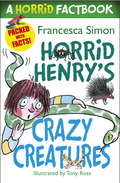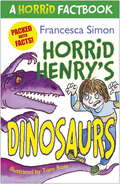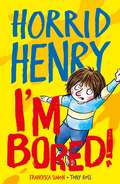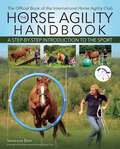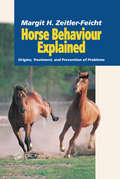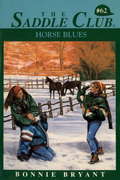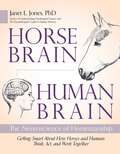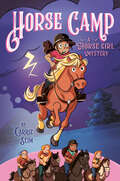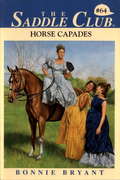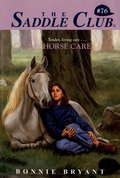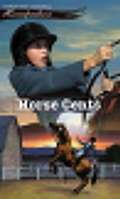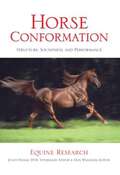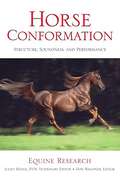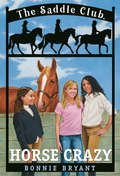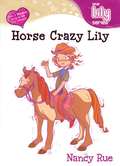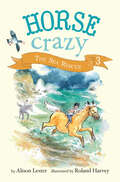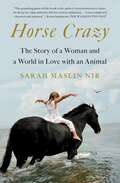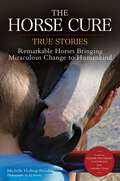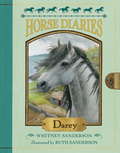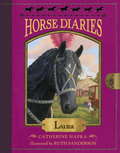- Table View
- List View
Horrid Henry's Crazy Creatures: A Horrid Factbook (Horrid Henry #1)
by Francesca SimonFrom multi-million-copy selling author, Francesca Simon, and David Walliams' illustrator, Tony Ross, comes the latest title in the successful Horrid Henry's Factbooks series. What's the only animal in the world to produce cube-shaped poo? What kind of lizard looks as though it has two heads? And what happens when a tarantula loses a leg?Bursting with foul facts and twisted trivia, this is the perfect guide to everything a Horrid Henry fan has ever wanted to know about animals. Gross out your family and amaze your friends with your nasty new knowledge!
Horrid Henry's Crazy Creatures: A Horrid Factbook (Horrid Henry Ser.)
by Francesca SimonFrom multi-million-copy selling author, Francesca Simon, and David Walliams' illustrator, Tony Ross, comes the latest title in the successful Horrid Henry's Factbooks series. What's the only animal in the world to produce cube-shaped poo? What kind of lizard looks as though it has two heads? And what happens when a tarantula loses a leg?Bursting with foul facts and twisted trivia, this is the perfect guide to everything a Horrid Henry fan has ever wanted to know about animals. Gross out your family and amaze your friends with your nasty new knowledge!
Horrid Henry's Dinosaurs: A Horrid Factbook (Horrid Henry #1)
by Francesca SimonPacked with freaky facts and random trivia, this is the perfect guide to everything you ever wanted to know (and lots of things you might never have wanted to know) about Dinosaurs - Horrid Henry style!
Horrid Henry: Funny facts and hilarious jokes to keep kids entertained whilst school's out! (Horrid Henry #1)
by Francesca SimonNumber One for Fiendish Fun! Help keep the kids busy whilst school's out with this bumper activity book! Featuring Horrid Henry's Animals: A Horrid Factbook and Horrid Henry's Hilariously Horrid Joke Book.Horrid Henry is so BORED stuck at home! It's a good thing that he's got this bumper activity book to entertain him. Bursting with weird animal facts, freaky trivia and 365 jokes, this book is the perfect companion for children aged 6+
Horrid Henry: Funny facts and hilarious jokes to keep kids entertained whilst school’s out! (Horrid Henry)
by Francesca SimonNumber One for Fiendish Fun! Help keep the kids busy whilst school''s out with this bumper activity book! Featuring Horrid Henry''s Animals: A Horrid Factbook and Horrid Henry''s Hilariously Horrid Joke Book.Horrid Henry is so BORED stuck at home! It''s a good thing that he''s got this bumper activity book to entertain him. Bursting with weird animal facts, freaky trivia and 365 jokes, this book is the perfect companion for children aged 6+
Horse Agility Handbook
by Vanessa BeeTHE AMAZING THING about horses is there's one out there suited for just about every human. They come in all colors, shapes, and sizes, and we've trained them to excel at any number of riding sports that appeal to human personalities across the board. But until now, there hasn't been an internationally recognized, competitive horse sport dedicated to those horse lovers who most enjoy working their horse from the ground. With Horse Agility, that's all changing. Over the past few decades, an evolution in how we go about training horses has encouraged horse owners to spend more time handling their horse on the ground in order to achieve good behavior, mutual trust, and a healthy partnership — before they ever think about getting in the saddle. This has created a generation of horsemen and women perfectly poised to pursue the competitive and social benefits of the sport of Horse Agility. Think, for a moment, of the hugely popular Dog Agility classes you've no doubt seen — it is no secret they're enjoyed by countless canines and their handlers, all over the world. With great exuberance and palpable enjoyment, a dog dashes around a colorful obstacle course, following subtle direction from his handler. Usually this occurs without a leash, and without other devices designed to persuade him to participate. The dog completes the course because he chooses to — NOT because he is constrained, forced, whipped, prodded, or bribed. Horse trainer Vanessa Bee, founder of the International Horse Agility Club, says that we need to change the way we think about horses and the sports and activities we so often pursue with them. She sees no reason the horse cannot enjoy your time together so much, he will choose to play with you—over, under, and through obstacles, without a lead rope, even when loose in a large, grassy pasture. Hard to believe? Try it for yourself! The Horse Agility Handbook has all you need to get started in the sport, including lessons in handling and body language, directions for obstacle and course construction, and information for managing competitions and play days.
Horse Behaviour Explained: Origins, Treatment and Prevention of Problems
by Margit Zeitler-FeichtThis book is a general guide to understanding horse behavior, how the horse learns and how horse handlers can adjust their behavior to avoid creating anxiety in the horse. The author begins by providing an overview of the evolution of the horse and the consequences of domestication. She goes on to provide a very detailed description of normal equin
Horse Blues (Saddle Club #62)
by Bonnie BryantThe girls in the Saddle Club are making New Year's resolutions, but keeping them won't be easy. Can Stevie be nice to Veronica for a whole month? Can Lisa learn embroidery to make her mother happy? And will Carole give up junk food? The first one to waver from their resolution must pay a price!
Horse Brain, Human Brain
by Janet JonesHorsemanship of every kind depends on mutual interaction between equine and human brains. When we understand the function of both, we can learn to communicate with horses on their terms instead of ours. And, by meeting horses halfway, we not only save valuable training time and improve performance, we achieve other goals, too. We develop much deeper bonds with our horses; we handle them with insight and kindness instead of force or command; we comprehend their misbehavior in ways that allow solutions; and we reduce the human mistakes we often make while working with them. In this illuminating book, brain scientist and horsewoman Janet Jones describes human and equine brains working together. Using plain language, she explores the differences and similarities between equine and human ways of negotiating the world. Mental abilities
Horse Breeds of North America: The Pocket Guide to 96 Essential Breeds
by Judith DutsonAn amazing variety of horse breeds roam North America’s vast and geographically diverse landscape. This detailed portable handbook celebrates the unique qualities of 96 regional breeds, from the sleek muscles of racing thoroughbreds and the stoic power of draft horses to the easy gait of pleasure horses at your local farm. Fascinating facts about each horse breed’s size, talents, and suitability for various types of work are accompanied by full-color photographs in this fun and informative reference guide.
Horse Camp: A Horse Girl Mystery (Horse Girl)
by Carrie SeimYEE-HAW! Willa is back in this standalone sequel to Horse Girl. This time, she tackles summer camp, new and old frenemies, and worst yet: a horse that's mysteriously gone missing.Seventh-grader Willa is head-over-hooves when she finds a secret note inviting her to Juniper Ranch—a sleepaway camp that&’s all about horses. The camp promises trail rides, horseback swims, and &“ghorst&” stories, plus tons of new horse-girl and (gasp!) horse-boy friends. Even better? Willa&’s pals from Oakwood Riding Academy—including her sworn frenemy, Amara—are all coming along for the fun.But when Willa makes a dangerous mistake and a beloved steed goes missing, everyone at Juniper Ranch is suddenly a suspect. Wills isn&’t sure who to trust (including herself) as she tries to figure out who&’s behind the mysterious horsenapping. And where they might be lurking. And just how she&’ll save her &“forever herd&” before a frightening storm rolls into camp. Gulp!
Horse Capades (Saddle Club #64)
by Bonnie BryantThe Saddle Club's number-one practical joker, Stevie Lake, has decided to reform. The only problem is, nobody believes her. Things get worse for poor Stevie when she tries to shoot a movie for school--Cinderella on horseback. After all, just because she's given up playing pranks on people, it doesn't mean she's given up wild schemes. But when no one in the cast cooperates, Stevie decides she has to revert to her old, practical joking ways . . . and then some. Watch out, Pine Hollow!
Horse Care (Saddle Club #76)
by Bonnie BryantHORSE CARE IS MORE THAN RIDING. When Lisa Atwood and her mother visit friends in a nearby town, Lisa doesn't expect to have a good time. She doesn't seem to have a lot in common with Marguerite, the friend's daughter, so it could be a long afternoon. But when Marguerite suggests that she and Lisa go riding, things start to look up. Marguerite's horse is gorgeous, and she's very pleased with it. In fact, she's so pleased that she rides off and leaves Lisa on a strange trail. Lisa doesn't mind too much--her horse is old but sweet-natured and it's a nice day. Then the mare stumbles, and Lisa is thrown. She can't ride and she can't walk. She's alone with just the horse for company. Can the horse care for Lisa and keep her safe until help arrives?
Horse Cents (Horsefeathers #2)
by Dandi Daley MackallSarah "Scoop" Coop's life revolves around her horse, Orphan, and the stability of the family stable business. Scoop learns major coming-of-age lessons as she learns to rely on God.
Horse Color Explored
by Vera KurskayaEveryone stops and stares at a horse with beautiful or unusual color. So striking are the variations of bay, gray, chestnut, black, solid, and spotted that many people breed for specific combinations. This has led to a marked increase in international interest in the study of horse color genetics— well as a need for an easy-- reference suitable for the layperson who also wants to understand the science behind it all.In these pages, horsewoman and genetics specialist Vera Kurskaya provides a guide that aims to not only provide basic information about horse color appropriate for a general audience, but also explore the specifics of inheritance and recent color genetics research certain to inform serious aficionados worldwide. With 160+ color photographs in handy reference sections throughout, as well as a look at special hair features, the evolution of horse color, and the effect of color on performance, fertility, and character,Horse Color Exploredis a fascinating and valuable resource for the modern horseperson.a Manchado horsea Rabicano horse
Horse Conformation: Structure, Soundness, And Performance
by Equine ResearchIn athletics as in architecture, form follows function, and nowhere is that truth more important than in equestrian sports. The better a horse's conformation (how the animal measures up to, or "conforms," to the ideal standards of its breed or type), the better it will be able to perform. Using hundreds of photographs and drawings, this masterfully produced book will show you how to develop the "eye" that any horseman needs to assess equine conformation and anatomy. Its comprehensive text focuses on ideal and abnormal conformation features; balance and symmetry; the relationship between conformation faults and athletic ability; colors and markings; as well as anatomical elements, teeth, and aging; body systems; and the relationship between structure and function. Now in paperback, HORSE CONFORMATION is the single most valuable book on its subject and one that deserves a prominent place in every horse owner's or rider's library.
Horse Conformation: Structure, Soundness, and Performance
by Equine ResearchIn athletics as in architecture, form follows function, and nowhere is that truth more important than in equestrian sports. The better a horse's conformation (how the animal measures up to, or "conforms," to the ideal standards of its breed or type), the better it will be able to perform. Using hundreds of photographs and drawings, this masterfully produced book will show you how to develop the "eye" that any horseman needs to assess equine conformation and anatomy. Its comprehensive text focuses on ideal and abnormal conformation features; balance and symmetry; the relationship between conformation faults and athletic ability; colors and markings; as well as anatomical elements, teeth, and aging; body systems; and the relationship between structure and function.
Horse Country
by Susan Yoder AckermanKyle is afraid of horses, so the last thing he wants to do is go horseback riding with his Aunt Maggie. As he interacts with them and learns more about them, however, he begins to appreciate them. He learns that horses are not just pets—they can also be friends!
Horse Crazy (Saddle Club #1)
by Bonnie BryantCarole Hanson and Stevie Lake have been best friends ever since they met at Pine Hollow Stables. So when Lisa Atwood joins their ridinggroup, the girls aren't sure she's got what it takes. Lisa may be the smartest student in the classroom, but she's got a lot to learn when it comes to horses. . . .
Horse Crazy Lily
by Nancy RueLily's in love! With horses?! Back in the "saddle" for another exciting adventure, Lily's gone western and destined to be the next famous cowgirl. After her first horseback-riding experience, Lily's hooked. Her room practically turns into a stable and her life is all about horses. Of course her pleas for her very own horse go unacknowledged, so Lily does the next best thing . . . she gets an unofficial job at a stable. But does she do it for the love of horses or to escape dealing with her new adopted sister Tessa? When the unthinkable happens at the stable, Lily is left wondering, Where is God? Why did he let it happen?, but learns a real lesson in faith and who God really is.
Horse Crazy: The Sea Rescue
by Len VlahosDuring summer vacation at Whale Bay, Bonnie and Sam are charged with shearing sheep and taking care of two horses, Tex, who is afraid of the ocean, and Blondie. Along the way, they stumble across clues to a mystery at Skull Rock. Kids won't be able to resist this page-turner as Bonnie and Sam put together the clues and catch the abalone poachers!
Horse Crazy: The Story of a Woman and a World in Love with an Animal
by Sarah Maslin NirONE OF USA TODAY'S &“20 SUMMER BOOKS YOU WON'T WANT TO MISS&” In the bestselling tradition of works by such authors as Susan Orlean and Mary Roach, a New York Times reporter and Pulitzer Prize finalist explores why so many people—including herself—are obsessed with horses.It may surprise you to learn that there are over seven million horses in America—even more than when they were the only means of transportation—and nearly two million horse owners. Acclaimed journalist and avid equestrian Sarah Maslin Nir is one of them; she began riding horses when she was just two years old and hasn&’t stopped since. Horse Crazy is a fascinating, funny, and moving love letter to these graceful animals and the people who—like her—are obsessed with them. It is also a coming-of-age story of Nir growing up an outsider within the world&’s most elite inner circles, and finding her true north in horses. Nir takes readers into the lesser-known corners of the riding world and profiles some of its most captivating figures. We meet Monty Roberts, the California trainer whose prowess earned him the nickname &“the man who listens to horses,&” and his pet deer; George and Ann Blair, who at their riding academy on a tiny island in Manhattan&’s Harlem River seek to resurrect the erased legacy of the African American cowboy; and Francesca Kelly, whose love for an Indian nobleman shaped her life&’s mission: to protect an endangered Indian breed of horse and bring them to America. Woven into these compelling character studies, Nir shares her own moving personal narrative. She details her father&’s harrowing tale of surviving the Holocaust, and describes an enchanted but deeply lonely upbringing in Manhattan, where horses became her family. She found them even in the middle of the city, in a stable disguised in an old townhouse and in Central Park, when she chased down truants as an auxiliary mounted patrol officer. And she speaks candidly of how horses have helped her overcome heartbreak and loss. Infused with heart and wit, and with each chapter named after a horse Nir has loved, Horse Crazy is an unforgettable blend of beautifully written memoir and first-rate reporting.
Horse Cure
by Michelle Holling-BrooksASHLEY was locked in closets as punishment, and physically and sexually abused, resulting in an angry and violent child who threatened her adoptive family—until she met Cocoa and Radar, the horses that helped her learn to trust again. BRENDA was diagnosed bipolar and lived through humiliating domestic abuse, but three horses—Delilah, Wiscy, and Diesel—helped her establish a sense of self-worth, hope for the future, and ultimately, the will to go on. NICK was angry, suicidal, and a veteran with combat PTSD, who now says, &“Horses literally saved my life.&” Inspired by her own childhood trauma when she spent seven days in a coma, awakened to a severely compromised body and brain, and rebuilt her life with the help of a horse, Michelle Holling-Brooks founded Unbridled Change, a non-profit Equine-Partnered Therapy organization that helps match horses to individuals in need. Here she shares amazing stories of the people she&’s worked with and the &“horse cure&” that changed their lives. Survivors of trauma, loss, illness, abuse, stress, and depression can face seemingly insurmountable obstacles. But today, a growing body of scientific evidence suggests that horses play a crucial role in therapy for those struggling with significant psychological and emotional challenges. Horses respond to angry, inhibited, heartbroken, defiant, terrified clients in many different ways, often breaking through defensive barriers via their physical presence, or by pointing to areas of psychological distress not immediately apparent. The horse&’s response guides the treatment team, as well as the client, in the healing process.
Horse Diaries #10: Darcy
by Ruth Sanderson Whitney SandersonIreland, 1917. Darcy is a light gray Connemara pony with silver dapples. She's fast and tough, whether she's pulling a load of peat from the bog or riding around the rugged countryside with Shannon McKenna, her human family's eldest daughter. But when Mrs. McKenna needs a doctor, Darcy discovers a skill that will change her and her family's life forever. Like Black Beauty, this moving novel is told in first person from the horse's point of view and includes an appendix full of photos and facts about Connemara ponies and Irish history.
Horse Diaries #12: Luna
by Catherine Hapka Ruth SandersonFor all lovers of horses and history, the beloved Horse Diaries series is heading to the circus! A beautiful Friesian horse and the younger sister of a circus star develop a heartwarming friendship in this sweet and lively story told straight from the horse's mouth. The Netherlands, 1855 Luna is a black Friesian mare with one small white crescent- moon marking on her forehead. She lives a quiet life on a farm . . . until the circus comes to town! Luna bonds with a girl named May, who dreams of starring in the show, just like her older sister. And together, Luna and May just might be able to shine. Here is Luna's story . . . in her own words.
